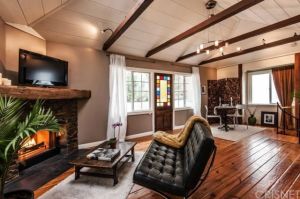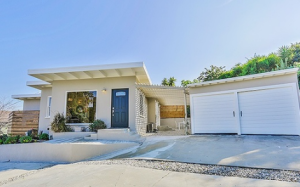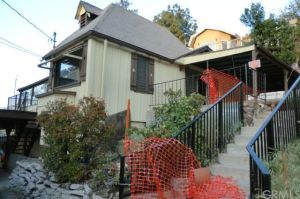I won’t belabor the point, nor will I continue to write on this topic, but I ask that my readers give me one more chance to discuss the topic of housing in Los Angeles.
I decided yesterday to run the numbers and see what my husband and I could afford to buy in the greater Los Angeles area. My husband is an attorney, and I am a tenured professor at a local college. We are not rich by any stretch of the imagination, but we’re certainly making a respectable income. We are solidly middle class. Anywhere else in the country, owning our home would be expected and relatively easy to do; but here, we can afford a $408,000 home. What does that get you in Woodland Hills, the city where our jobs happen to be? NOTHING. There is NO HOME CURRENTLY FOR SALE that would could buy. There was one, but they were only accepting all cash offers. Who has all cash? The multitudes of investors buying all of the houses in the area and renting them out for absurd prices.
I checked Calabasas and Agoura. There was one house, and here it is:
I love old houses, don’t get me wrong; my dream is to live in a house from the 1920s, and here is a house!!! So, what’s the problem? Well, for starters, it has 700 square feet. The other issue? It’s in such terrible condition that it must be torn down. I know this because my husband and I actually visited this home a year ago when the residents were clearing out the house. No renovations had been done in at least 60 years, and the entire foundation was crumbling. The list of what is wrong with this place would take many hours to detail, but suffice to say that I am VERY willing to fix up an old house, and even I could not imagine how I could even start to fix this disaster.
Here is a house that we cannot afford to buy in Woodland Hills (it’s about $90,000 too high, but it’s the closest thing I can find):

Very pretty, right? 700 square feet. No garage. No bathroom on the ground floor. A kitchen the size of a closet.
The one above is in the cheapest neighborhood in Woodland Hills. It’s a vintage Girard cabin. Perfect for us. I checked it out with great enthusiasm and high hopes. Even in our wildest dreams, we don’t fit into a 700 square foot home. This one is surrounded by houses that stare down at the tiny backyard, and there is nowhere to park and no garage. The bedroom is downstairs and requires one to walk up a circular, metal staircase in order to use the one bathroom. It used to be a rock musician’s studio. No one ever thought to actually live there. The kitchen is the tiniest affair I have ever seen–it is literally smaller than my very small closet.
The monthly payment for the above homes is around $4,000 per month if you add in taxes, insurance, PMI and fees that the FHA charges for their 3.5% down payment program.
The home we rent has 1100 square feet, two bedrooms, two bathrooms, a huge deck with a killer view of the entire Valley, a big kitchen, is on a fabulous street with much more expensive homes and is vintage 1962 in excellent condition. We pay $2300 per month, and the rental company takes care of all maintenance and repairs.
We all know this, I suppose, but it’s recent news to my stubborn self. Unless you are an all-cash investor, a flipper, a huge rental conglomerate, a REIT or a millionaire, you will not be buying a home in the Los Angeles area. So what, you might say. Who cares? I care. When you squeeze out the middle class to the point that over 70% of Angelinos cannot afford to buy a home, you create a situation where families have to cram into tiny apartments and cannot invest in their neighborhoods or help to create a community. The history, charm and beauty of the many neighborhoods in Los Angeles is lost as investors buy up and tear down historic homes, or they gut them and “remodel” them with the cheapest Home Depot specials so that they are “renter friendly.” The owners in our neighborhoods are no longer families who carefully tend to their yards and who host block parties and yard sales. We are the middle class, and we can’t lovingly build and create our local communities, because we are not allowed in.
As much as I need to rent and appreciate the ability to do so, I also know that I don’t improve the property or make a big effort to garden and paint because it’s not my house. I keep it up, but I don’t do all those little things that homeowners do. I would have painted the front door. I would have replaced the spider plants with rosemary. I would have terraced the back hill. I would have repainted the trim and stripped the kitchen cabinets. All those little projects that make a house a home are on indefinite hold, because I know that I am a temporary occupant of that house. I sign papers that say I have one more year to live there, MAYBE another year after that, but at some point, the owner will decide to sell, and we won’t be able to afford to buy it. So we’ll move on to another rental property unless the real estate market has crashed to the point that we can afford to buy.
We are taught that owning a home is one of those markers of adulthood, something that makes us true members of a community and allows us to upgrade not only our home, but the entire neighborhood. We grow up believing that only the young, the poor or the unstable and uncommitted choose to rent. Of course, that’s not true; but the ideology of this country pushes us in the direction of owning. I know realize that this is purely an economic reality and has nothing to do with status, morals, values or some home-spun Rockwell painting depicting the American Dream. We are pushed hard into buying a home by a culture bought and paid for by banks, lenders, agents and other financial institutions and . . . dare I say it . . . our own government, based on one thing and one thing only: they all make lots of money if we buy houses. The further we sink into debt, the more money we throw into a hugely inflated mortgage, the more fees and insurance we cough up, the more money our financial institutions make, and all those associated with them.
I watched more than half of the people in my old neighborhood undergo extreme financial and emotional trauma as most lost their houses and were forced to move. The pain was–as is–palpable, as houses sit vacant and start to fall apart. How could we possibly think that the crisis is over? It’s only over for the wealthy. It’s not over, not by a long shot, for the middle class Angelino. I’m grateful for my little house on the hill, don’t get me wrong–but something is wrong when I realize that we will never be able to purchase a home in the town we call home, the town where we work, the neighborhoods that we love and have dedicated much time and energy to. We serve this community in a variety of ways, and yet we cannot put down roots here and feel that we are truly welcome to stay as long as we wish.
This is really about the abysmal differences in social class in this part of the world. It’s really about the fact that the middle class is sliding down that economic ladder while others occupy the top 1%. What do we need? Do I dare say, a revolution?
–Kirsten A. Thorne, PhD


I feel your pain, Kirsten. We moved to Phoenix just so we could save up enough money to come back to LA and buy our first house here. We were in Phoenix 14 years! But we finally saved enough to buy a foreclosed property in LA and fix it up. After two years, we sold that one and bought another home in a better location that didn’t need as much work. Hang in there!
At last ~ an article depicting how the “Great American Dream” has become the “Great American Nightmare”! Well thought out and presented, Kirsten. We believed that the middle class would somehow regain it’s stamina and return to it’s former good health. It wasn’t to be and we continue to be faced with prolonged apartment living with no hope in sight in becoming home owners. California, generally speaking, is a difficult state for the middle class to survive in. I can only suggest researching other states extensively for employment first ~ then home ownership. This sort of activity really contributes greatly to regaining hope. The benefits of exploration are many, and willingness to do so are well worth it all. Your honesty and straightforwardness is greatly appreciated, Kirsten and will encourage many to look beyond the boundaries of CA. It becomes a matter of survival and is not an impossibility .
Thank you so much for writing, Eileen. I really appreciate your comments. I decided, about a year and a half ago, that I would look in odd areas at ‘undesirable’ houses, and so I did–and found a house that stank of smoke and was super dated, but was located in the mountains between Chatsworth and Simi Valley. The location was amazing, but nobody wanted the house because it smelled bad and the kitchen was vintage 1980s. So, my husband and I purchased it for cheap, I cleaned it from top to bottom, we made the necessary repairs, and here we are: homeowners!!! So, yes, it’s possible; but you have to really look at the ugly ducklings and use your imagination. You also have to move yourself outside of your comfort zone and look in areas that are considered ‘less desirable,’ and often you will find that the house that nobody wants is the perfect house. So yes, we’re back in the game; but it required a great deal of introspection, willingness to compromise, and most of all, the willingness to see past the flaws and problems and know that there was a jewel under all the dirt and smoke!